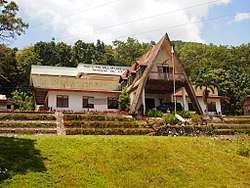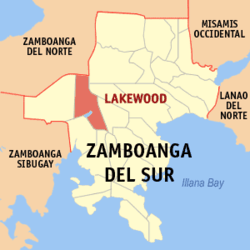Lakewood, Zamboanga del Sur
| Lakewood | |
|---|---|
| Municipality | |
| Municipality of Lakewood | |
 Lakewood Municipal Hall | |
 Map of Zamboanga del Sur with Lakewood highlighted | |
.svg.png) Lakewood Location within the Philippines | |
| Coordinates: 7°51′N 123°10′E / 7.85°N 123.17°ECoordinates: 7°51′N 123°10′E / 7.85°N 123.17°E | |
| Country |
|
| Region | Zamboanga Peninsula (Region IX) |
| Province | Zamboanga del Sur |
| District | 2nd District |
| Founded | November 11, 1977 |
| Barangays | 14 (see Barangays) |
| Government [1] | |
| • Type | Sangguniang Bayan |
| • Mayor | Canuto C. Enerio Jr. |
| • Electorate | 11,338 voters (2016) |
| Area [2] | |
| • Total | 201.30 km2 (77.72 sq mi) |
| Population (2015 census)[3] | |
| • Total | 20,374 |
| • Density | 100/km2 (260/sq mi) |
| Time zone | UTC+8 (PST) |
| ZIP code | 7014 |
| PSGC | 097333000 |
| IDD : area code | +63 (0)62 |
| Climate type | Tropical climate |
| Income class | 4th municipal income class |
| Revenue (₱) | 81,273,761.71 (2016) |
| Native languages |
Subanon language Cebuano Chavacano Tagalog |
| Website |
www |
Lakewood, officially the Municipality of Lakewood, (Subanen: G'benwa Danaw), is a 4th class municipality in the province of Zamboanga del Sur, Philippines. According to the 2015 census, it has a population of 20,374 people.[3]
The municipality was founded on November 11, 1977, when Barangays Gatub and Bagong Kahayag of the Municipality of Kumalarang and Barangays Lakewood, Bolalawan, Sebugay, Bisuangan, Lokoan, Backing, Dagum, Sapang Pinolis, Tubod, Gasa, Tiwales and Matalang of the Municipality of Lapuyan were separated and formed into an independent municipality named after Lake Wood, a large lake on which the poblacion is located.[4] The most popular species of fish in the province can only be caught in the lake: the carpa and porang.
The Subanen tribe is the major ethnic group living in the suburban areas; they cultivate vegetables and corn for their own use. Subanens have their own dialect, but they also speak Cebuano as a common dialect for conversation.
Barangays
Lakewood is politically subdivided into 14 barangays.
- Bagong Kahayag
- Baking
- Biswangan
- Bululawan
- Dagum
- Gasa
- Gatub
- Lukuan
- Matalang
- Poblacion (Lakewood proper)
- Sapang Pinoles
- Sebuguey
- Tiwales
- Tubod
- History
The old name of Lakewood is Danaw Likowai and Tubod is Obod. Now Barangay Tubod is the largest barangay and most populated barangay, serving as a gateway to the town. Its name derives from the Cebuano term tubod which means "spring". It has a hospital, the Singidas Medical Clinic, which is regarded as the cleanest hospital of the town. The Lily's Hidden Spring in the upper part of Tubod, and Mainit Waterfall in the lower part of Gatub are among Lakewood's tourist attractions.
Demographics
| Population census of Lakewood | ||
|---|---|---|
| Year | Pop. | ±% p.a. |
| 1980 | 12,896 | — |
| 1990 | 13,376 | +0.37% |
| 1995 | 14,601 | +1.66% |
| 2000 | 16,317 | +2.41% |
| 2007 | 18,562 | +1.79% |
| 2010 | 19,645 | +2.09% |
| 2015 | 20,374 | +0.70% |
| Source: Philippine Statistics Authority[3][5][6][7] | ||
References
- ↑ "Municipality". Quezon City, Philippines: Department of the Interior and Local Government. Retrieved 31 May 2013.
- ↑ "Province: Zamboanga del Sur". PSGC Interactive. Quezon City, Philippines: Philippine Statistics Authority. Retrieved 12 November 2016.
- 1 2 3 Census of Population (2015). "Region IX (Zamboanga Peninsula)". Total Population by Province, City, Municipality and Barangay. PSA. Retrieved 20 June 2016.
- ↑ "Presidential Decree No. 1236: Creating the Municipality of Lakewood in the Province of Zamboanga del Sur". The Lawphil Project. Arellano Law Foundation, Inc. Retrieved 21 July 2014.
- ↑ Census of Population and Housing (2010). "Region IX (Zamboanga Peninsula)". Total Population by Province, City, Municipality and Barangay. NSO. Retrieved 29 June 2016.
- ↑ Censuses of Population (1903–2007). "Region IX (Zamboanga Peninsula)". Table 1. Population Enumerated in Various Censuses by Province/Highly Urbanized City: 1903 to 2007. NSO.
- ↑ "Province of Zamboanga del Sur". Municipality Population Data. Local Water Utilities Administration Research Division. Retrieved 17 December 2016.